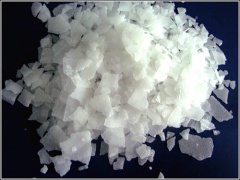Caustic Soda
| Infobox on Caustic Soda | |
|---|---|
| Example of Caustic Soda |  |
| Facts | |
| Origin | - |
| Stowage factor (in m3/t) | 0,71/1,26 m3/t (drums) |
| Humidity / moisture | - |
| Ventilation | - |
| Risk factors | See text |
Caustic Soda
Contents
Description
Sodium Hydroxide (NaOH), also known as lye and caustic soda, is a caustic metallic base. It is used in many industries, mostly as a strong chemical base in the manufacture of pulp and paper, textiles, drinking water, soaps, detergents, drain cleaner and in the refining of vegetable oils.
Pure sodium hydroxide is a white solid available in pellets, flakes, granules, and as a 50% saturated solution. It is hygroscopic and readily absorbs water from the air, so it should be stored in an airtight container. It is very soluble in water with liberation of heat. It also dissolves in ethanol and methanol, though it exhibits lower solubility in these solvents than does Potassium Hydroxide. Molten Sodium Hydroxide is also a strong base, but the high temperature required limits applications. It is insoluble in ether and other non-polar solvents. A sodium hydroxide solution will leave a yellow stain on fabric and paper.
Caustic soda or lye is known chemically as sodium hydroxide. It is called caustic soda because of its burning or caustic effect on the skin. It is one of the basic raw materials of the great alkali industry which, in itself, is one of the most important parts of the chemical industry.
Caustic soda is produced commercially in either of two ways, the electrolysis of brine or the Soda-Lime Process. Pure caustic soda is a white solid that is very soluble in water. It is deliquescent, absorbing water from the air and dissolving in it. In this way it is carried in bulk as a 50% or 70% solution; it is known as caustic soda liquor and is a colourless or grey, syrupy liquid with a slight characteristic odour.
Caustic soda is a caustic alkali (strong base) which attacks and decomposes organic matter. It dissolves wool and silk and eventually reacts with cellulose to form a compound from which viscous rayon is manufactured. It reacts with fats to form soaps, dissolving fat and grease. Other uses of caustic soda are:
1) Removal and solution of waste in plumbing. As a household lye, caustic soda is poured down clogged drains where it liquefies or dissolves waste fat and grease, making them soluble in water.
2) Petroleum purification. Caustic soda is used to neutralize the sulphuric acid employed in purifying petroleum.
3) Manufacture of mercerized cotton. Cotton cloth when treated under tension in a solution of caustic soda becomes stronger and more lustrous. Cotton treated in this manner is known as mercerized cotton.
4)Reclaiming rubber, etching and electroplating.
Also: chemical manufacture, rayon and cellophane, neutralizing agent in petroleum refining; pulp and paper, aluminium, detergents, soap, textile processing, vegetable oil refining, reclaiming rubber, regenerating ion exchange resins, organic fusions, peeling of fruits and vegetables in food industry, lab reagent, food additive.











